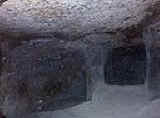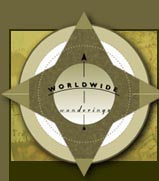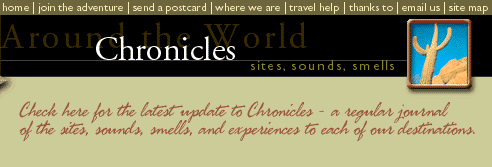Oct.
8-10, 1998 Ankara/Cappadocia, Turkey We wake in Ankara to a
beautiful day of bright sunshine. Rhea, our guide, tells us that everyday has sunshine in
Turkey. Even when it snows, the sun comes out to bathe the earth. The sun is certainly
shinning on us for the next two days. It seems that we have a private car, driver, and
guide. Our first stop is the Museum of Anatolian. Museum in Turkey has a whole new
meaning. To these folks, old isn’t a few hundred years, it’s a few thousand. The
museum houses artifacts from 2,300,000 (count ‘em 0’s) B.C., up to 500 B.C! Next
stop: Anit Kabir – the mausoleum of Kemal Ataturk, founder of the 75 year old Turkish
Republic. We hop in the van at about noon for a three hour drive to our next destination.
As we travel by Hyunda minivan to Cappadocia, the flat, open road stretches out in front
of us. Sprawling, farmland forever. On either side of us there are rolling hills for as
far as the eye can see.
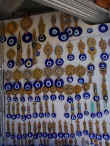 And speaking of eyes, we notice that they are everywhere in
Turkey. Pictures, sculptures, paintings. In gift shops. On the back of autos. On the
tailgates of trucks. Hanging from doorways. Eyes everywhere, and they’re all blue
ones. Rhea explains to us that these are symbols intended to ward off evil. It seems that
in the early days, people with blue eyes were rare and unfamiliar, and thus were
considered evil. Couple that with the fact that the Turks believe that feelings and
emotion toward others are sent through the eyes, and the result is the blue eye icon. The
icon comes in all shapes and forms and is sometimes surrounded with glass or reflective
metal. The eye, placed facing outwards, wards off and reflects evil coming its way. Long
story short - the next time someone mentions getting ‘the evil eye’, you’ll
have the opportunity to amaze them with this tale of its origin.
And speaking of eyes, we notice that they are everywhere in
Turkey. Pictures, sculptures, paintings. In gift shops. On the back of autos. On the
tailgates of trucks. Hanging from doorways. Eyes everywhere, and they’re all blue
ones. Rhea explains to us that these are symbols intended to ward off evil. It seems that
in the early days, people with blue eyes were rare and unfamiliar, and thus were
considered evil. Couple that with the fact that the Turks believe that feelings and
emotion toward others are sent through the eyes, and the result is the blue eye icon. The
icon comes in all shapes and forms and is sometimes surrounded with glass or reflective
metal. The eye, placed facing outwards, wards off and reflects evil coming its way. Long
story short - the next time someone mentions getting ‘the evil eye’, you’ll
have the opportunity to amaze them with this tale of its origin.
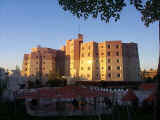 As the sun sets, we pull into our temporary home
for the next two days – The Kapadokya Lodge Country Club. This striking four star
resort was designed to mimic, and as such, be a complimentary part, of its surroundings.
The lodge's sand and light pink colored walls glow warmly in the light of the setting sun.
I really have to hand it to Laura on this one, she set us up first class. A very restful
night flows easily into the next morning, as we greet our guide and driver for a full day
of adventure and entertainment courtesy of Mother Nature.
As the sun sets, we pull into our temporary home
for the next two days – The Kapadokya Lodge Country Club. This striking four star
resort was designed to mimic, and as such, be a complimentary part, of its surroundings.
The lodge's sand and light pink colored walls glow warmly in the light of the setting sun.
I really have to hand it to Laura on this one, she set us up first class. A very restful
night flows easily into the next morning, as we greet our guide and driver for a full day
of adventure and entertainment courtesy of Mother Nature.
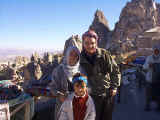 To
explain, it seems that about 3 million years ago all three of the area’s volcanoes
got together, decided stage a little protest, and proceeded to collectively ‘blow
their tops’. In so doing, tons of volcanic rock and ash covered the land. Packed down
by rainfall, the ash formed a very porous rock that is relatively easily eroded over time.
This type of rock is known as tuff. And, if by some chance, more solid material, or even
boulders were, at one time above this porous layer, the thousands of years of rainfall
would erode the tuff around these boulders, thus forming either large clusters, or
individual chimneys of tuff.
To
explain, it seems that about 3 million years ago all three of the area’s volcanoes
got together, decided stage a little protest, and proceeded to collectively ‘blow
their tops’. In so doing, tons of volcanic rock and ash covered the land. Packed down
by rainfall, the ash formed a very porous rock that is relatively easily eroded over time.
This type of rock is known as tuff. And, if by some chance, more solid material, or even
boulders were, at one time above this porous layer, the thousands of years of rainfall
would erode the tuff around these boulders, thus forming either large clusters, or
individual chimneys of tuff.
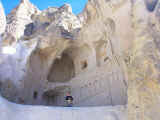 These
formations proved to be exceptional foundations for the ever-enterprising early
inhabitants of this bizarre, dream-like land, to carve-out what seem to be ancient
predecessors to the modern day high-rise condominium. Many of these structures were hewn
out by early Christians before the invasion of the Arabs in the territory. One such area
is in the Goreme Valley. As you can imagine, its not quite the same after these thousands
of years, but some of the fromer glory still remains of this village in the sky.
These
formations proved to be exceptional foundations for the ever-enterprising early
inhabitants of this bizarre, dream-like land, to carve-out what seem to be ancient
predecessors to the modern day high-rise condominium. Many of these structures were hewn
out by early Christians before the invasion of the Arabs in the territory. One such area
is in the Goreme Valley. As you can imagine, its not quite the same after these thousands
of years, but some of the fromer glory still remains of this village in the sky.
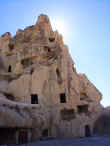 There are a total of six churches, some with their
walls and ceilings covered with very impressive frescos. (sorry, no pictures, a tourist
next to us took one and immediately the guards demanded his film – or fifty dollars,
we decided not to chance it). Each has a main room and small alter area with archways in
the ceilings, and alters and other tables carved out of the stone on the floors. St. Basil
(the founder) also had a nunnery (with SIX floors), as well as a monastery built on the
site.
There are a total of six churches, some with their
walls and ceilings covered with very impressive frescos. (sorry, no pictures, a tourist
next to us took one and immediately the guards demanded his film – or fifty dollars,
we decided not to chance it). Each has a main room and small alter area with archways in
the ceilings, and alters and other tables carved out of the stone on the floors. St. Basil
(the founder) also had a nunnery (with SIX floors), as well as a monastery built on the
site.
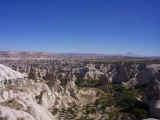 This
indescribably beautiful and intoxicatingly interesting land known as Capadocia is also
home to other rock villages such as Zelve, Pasabag, Urgup, and my personal favorite
Uchisar.
This
indescribably beautiful and intoxicatingly interesting land known as Capadocia is also
home to other rock villages such as Zelve, Pasabag, Urgup, and my personal favorite
Uchisar.
As a matter of fact, Uchisar became the scene of a little scolding from of tour guide,
Rhea. It just so happened that when we arrived in this small hamlet area, Rhea darted off
to greet some friends from the village. She made the mistake of doing so BEFORE telling us
that this was to be only a picture stop – and NOT an opportunity to explore. Well,
those of you who know me probably won’t be surprised when I explain that after about
10 minutes of being unsupervised, I convinced Laura that it was O.K., and for that matter
even intended, for us to hike up the path and then up the cracks and crevases of the
rock-blocks to the very top, of course exploring each of the little rooms that we could
reach along the way.
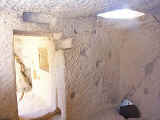 This, apparently, was not in Rhea’s agenda, for, when an hour (or so)
later we came bounding down the path to the bus, she stood waiting in classic ‘female
that’s mad-as-a-hornet’ stance. We all know it well, and yes, it is Universal.
Face in a scowl, hands on the hips, one foot slightly in front of the other, rapidly
tapping the ground. She proceeded to let me have it, and I just stood there patiently and
simply listened. My lack of reaction seemed to upset her even more, until, at last, she
got so frustrated that she just stopped yelling and abruptly turned to back down the hill
toward the bus. Oh well, all in a day’s work of this traveling stuff.
This, apparently, was not in Rhea’s agenda, for, when an hour (or so)
later we came bounding down the path to the bus, she stood waiting in classic ‘female
that’s mad-as-a-hornet’ stance. We all know it well, and yes, it is Universal.
Face in a scowl, hands on the hips, one foot slightly in front of the other, rapidly
tapping the ground. She proceeded to let me have it, and I just stood there patiently and
simply listened. My lack of reaction seemed to upset her even more, until, at last, she
got so frustrated that she just stopped yelling and abruptly turned to back down the hill
toward the bus. Oh well, all in a day’s work of this traveling stuff.
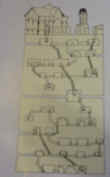 The following day (after making up with Rhea) our
schedule dictated a day rather opposite from the one before. Instead of climbing up into
houses and chapels chiseled from cliffs and pyramids of stone, we were about to crouch
down and crawl into five levels of the UNDERGROUND city of Kaymakli. It may not be the
same for those of the female persuasion, but for a male of any age, climbing around in an
underground maze of little rooms, passageways, and tunnels is the ULTIMATE in playing
‘fort’. It was obvious that I was beside myself with fascination, as Laura and
Rhea constantly had to wait for me to catch up to them after taking little side trips into
almost every room (including, amongst others, bedrooms, a church, meeting hall, and
storage rooms) off of the planned pathway that they were following.
The following day (after making up with Rhea) our
schedule dictated a day rather opposite from the one before. Instead of climbing up into
houses and chapels chiseled from cliffs and pyramids of stone, we were about to crouch
down and crawl into five levels of the UNDERGROUND city of Kaymakli. It may not be the
same for those of the female persuasion, but for a male of any age, climbing around in an
underground maze of little rooms, passageways, and tunnels is the ULTIMATE in playing
‘fort’. It was obvious that I was beside myself with fascination, as Laura and
Rhea constantly had to wait for me to catch up to them after taking little side trips into
almost every room (including, amongst others, bedrooms, a church, meeting hall, and
storage rooms) off of the planned pathway that they were following.
